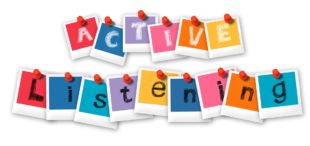Active Listening Exercises: How to Show You Care
Kristen Zuray
 While active listening is something people expect to come as naturally as hearing, there is a significant difference between hearing someone speak, and listening to what they say. If hearing is receiving sound waves through your ear, listening is the act of hearing the sound and understanding what you hear.
While active listening is something people expect to come as naturally as hearing, there is a significant difference between hearing someone speak, and listening to what they say. If hearing is receiving sound waves through your ear, listening is the act of hearing the sound and understanding what you hear.
The act of concentration allowing you to process meaning from words and sentences is different from active listening. This is a method of listening that keeps you focused on and connected with the other person in the conversation in a positive way.
The difference between hearing and listening
Active listening shows that while you are engaged in hearing what someone has to say, you demonstrate you have listened to them by being able to reflect the main points of what they said. You do this without showing judgment, expressing your ideas, and not offering your advice.
Consider when last you had a conversation with someone who made you feel heard and what you had to say was important. It was likely a result of their practicing active listening to what you had to say. Some experts regard active listening as a key part of any successful conversation, from those in your house with your family to friends in a social setting, and at work during meetings.
You will see that active listening comes more naturally to you when you are engaging with people whom you love. However, by keeping these active listening exercises in mind when you are joining in any conversation, you will improve your active listening skills so that they come more naturally to you. People will also benefit from deeper and more productive conversations with you that build trust.
Active listening exercises
Try these active listening exercises to build trust with your listeners and show them that you care about what they are saying.
Show you are paying attention
Think about when you are discussing something important. Do you enjoy it when your conversation partner looks away and is distracted? Surely not. Drawing from this lesson, be sure to show you are prioritizing what the other person is saying. Not just by hearing them, but also by showing them you see them and displaying your focus through good eye contact.
 Your refusal to be distracted also shows the level of your attention, like keeping your phone in your pocket. Your observations of the speaker’s body language are also important. Can you see that they are defensive or agitated?
Your refusal to be distracted also shows the level of your attention, like keeping your phone in your pocket. Your observations of the speaker’s body language are also important. Can you see that they are defensive or agitated?
What does your body language reveal to the person – are you engaged and showing it through your body language? Keep to body positions that show you are open and non-threatening by being aware of your facial expressions and, if appropriate, leaning into the conversation.
To show the person you’re truly tuned in, look at them and be mindful of nonverbal behaviors. Use open, non-defensive body language. Avoid folding your arms. Smile, lean in, and nod at key junctures. Consciously control your facial expressions, avoiding any gestures that convey negative impressions.
Reflect what you hear in your reply
There may be a temptation to assume the other person knows you have been actively listening. Not only have you heard them but have flawlessly understood them. This assumption often leads us to skip forward in the conversation to the part where it focuses on ourselves: our experience, our opinion, and our advice.
Before turning the focus of the conversation away from the person sharing, keep the focus on them even when they have stopped talking by describing how you understand what they have just said.
For example, “I can hear that you are concerned about…” before you summarize what you have heard them say. This simple act of taking the time to keep them and their concerns at the center of the interactive displays you validate them and are seeking to understand their point of view.
Suspend judgment
The fact that you have not made a judgment call during the conversation is reflected in the way you behave during it. Examples include allowing your speaking partner to communicate without interruption, letting them finish each point before asking any questions, and not interrupting them with counterarguments.
This helps the other person maintain a feeling of safety so they can continue to share their thoughts without the concern that their perspective will be used to shame, criticize, or manipulate them in any way.
Respond appropriately
 When you have shared your heart on a particular topic, does it feel good to get interviewed immediately afterward by the recipient asking closed questions that require no engagement, but simply information, such as fielding questions that only have a yes or no answer? These types of questions reflect less of an interest in the other person as compared to questions that require thoughtful, explanatory answers.
When you have shared your heart on a particular topic, does it feel good to get interviewed immediately afterward by the recipient asking closed questions that require no engagement, but simply information, such as fielding questions that only have a yes or no answer? These types of questions reflect less of an interest in the other person as compared to questions that require thoughtful, explanatory answers.
This does not mean you cannot ask for clarification. However, be aware of the temptation to follow-up clarification questions by diving into the detail. If you focus on the small details, you may miss the big picture. At this stage of the conversation, the focus is more on showing empathy than expertise.
Interrupting, finishing the other person’s sentences, or turning the focus of the conversation on yourself negates much of the purpose of the interaction up to this point. By listening not to understand but to insert your own point of view does the same.
Listening all the way to the end of the person’s point will help you respond to it in an appropriate manner, rather than by changing the subject, which instead tells them that you are bored and impatient to change the setting. Part of the value of the two people in the conversation is that one provides a solid emotional structure where the other can safely untangle their thoughts and feelings.
How do active listening exercises help?
Studies suggest that by training ourselves to be both open and able to practice interpretation during a conversation, we equip ourselves to better remember another person’s thoughts, ideas, feelings, and values. Interpretation is a key part of making sense of the information you receive by knowing how to connect it to your existing understanding and view of the world.
 Family:The ability to listen to your spouse or child when he or she is going through a difficult time is important, especially when he or she wants to be heard more than problem-solving, and provides encouragement and support to him or her.
Family:The ability to listen to your spouse or child when he or she is going through a difficult time is important, especially when he or she wants to be heard more than problem-solving, and provides encouragement and support to him or her.
Colleagues:In a supervisory position or when discussing matters with colleagues, active listening will help you cooperate and collaborate to deliver better solutions.
Friends:Active listening is a very good tool to employ when meeting new people and developing relationships. By practicing active listening exercises you will care more about what others have to say, and this in turn will improve your skills at initiating and maintaining conversations.
Benefits of role-playing
How does an active listener encourage others in the conversation to also become active in the conversation? To practice, finding a topic that interests you both. This will you both help develop new skills. When meeting new people it works particularly well during small talk, where the level of commitment to the conversation does not feel intimidatingly high.
At home, you can explain the concept to your children and then practice using topics in which they are interested. Have your child reflect back to you how your line of questioning made him or her feelings after the conversation.
When faced with someone who is not interested in returning the courtesy of active listening, ending the conversation with an explanation is one way of asserting your boundaries and encouraging others to respect them.
Christian counseling for listening within relationships
If you’re looking for additional help in active listening, browse our online counselor directory or contact our office to schedule an appointment. If someone you love is unable or unwilling to practice active listening, you still have hope by learning listening skills to improve your relationship. We would be honored to walk with you on this journey.
“Active Listening”, Courtesy of Geralt, Pixabay.com, CC0 License; “What?”, Courtesy of Robin Higgins, Pixabay.com, CC0 License; “Holding Hands”, Courtesy of 5688709, Pixabay.com, CC0 License; “Coffee Chat”, Courtesy of StockSnap, Pixabay.com, CC0 License;





